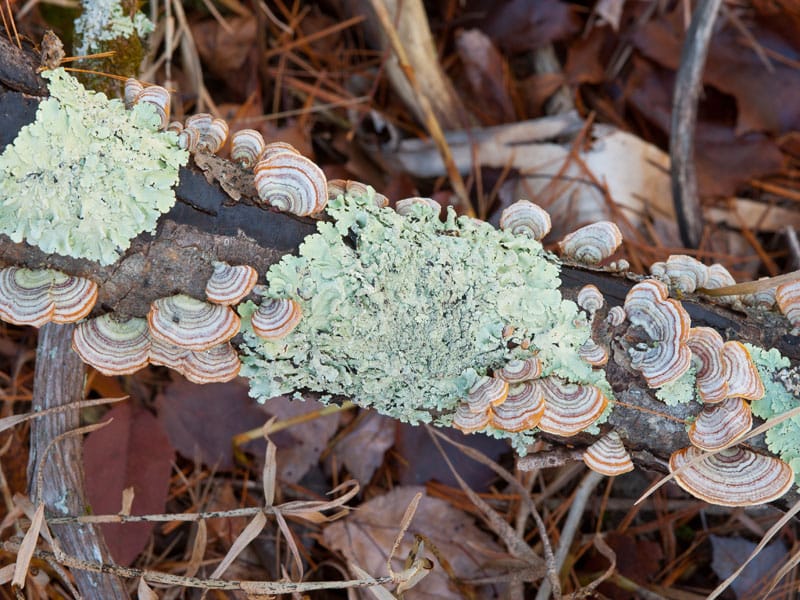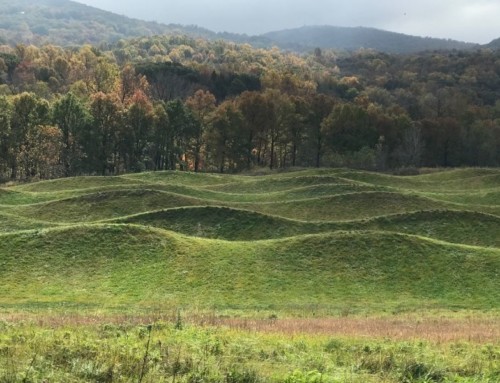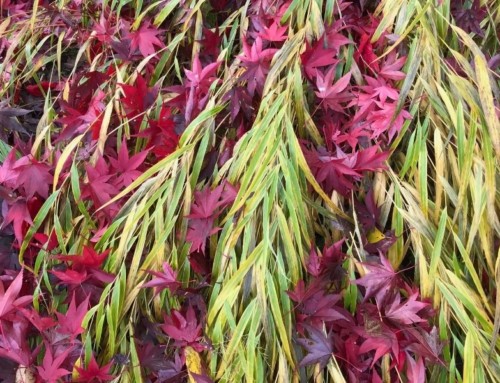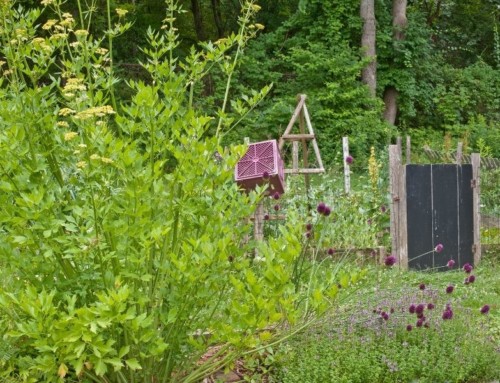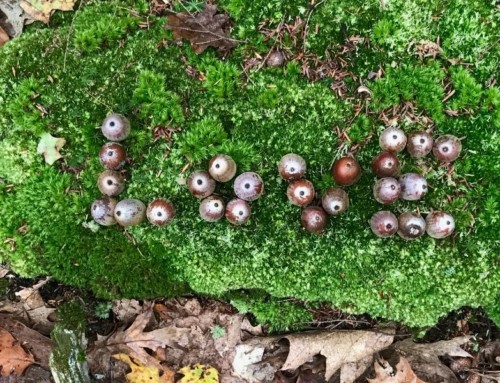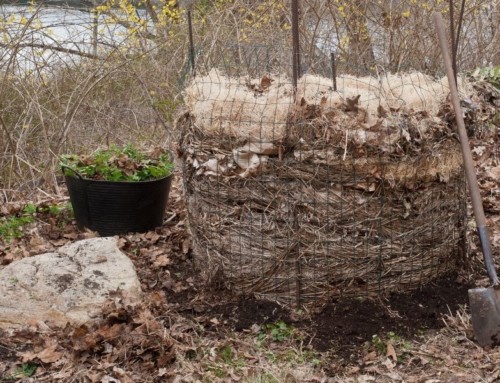For the longest time, fallen branches and trees obligingly came to rest lying across my steep back slope. This rather pleases my sense of order. They trace the contours of folded terrain, articulating the thrilling rise and fall of this land. Sideways-resting branches and trees prevent erosion. Water running down the mountain slows down, sinks in and keeps this precious resource right here at home. Leaves collect on the uphill side, breaking down into rich, spongy, life-filled soil.
This accidental arrangement “reads” in an interesting way from the house, so I tweak and embellish, connect lines, shape spaces. On mild winter days I go out and adjust whatever woody windfall isn’t frozen to the ground. It’s like a drawing on the land, with bold brush strokes, fine filigree, the rhythm of stair-stepped logs marching uphill. A sketch of white on brown before snow accumulates, a bumpy sculpture under deep snow, or dark against a snowy background, my rotting backyard artwork is always changing.
Dead and dying trees in the forest tend to fall in pieces over time, which is what’s going on big-time in my woods this winter. First the bark and limbs. Then chunks of trunk, piece by piece. Big pieces. Too-big-to-move cylinders that hit the ground and roll every which way. My lovely drawing is now a jumble of very big pieces. It’ll take chainsaws and strong backs to set things in order. In the meantime, it’s woodpecker heaven …
Humans (gardeners probably most of all) seem to have an innate urge to create – or impose – order on the land. I really like knowing that my playful pick-up-sticks arrangements function to improve the health of my backyard habitat.
I recently learned an interesting new word – “morticulture.”
WHAT IS “MORTICULTURE?”
Take a guess…
- Urban Dictionary: Horticulture, as practiced by poorly trained groundskeepers, which causes the mutilation and eventual death of landscape plants.
- A garden-based Indie rock band with punk elements in Phoenix, AZ
- The logging practice of leaving downed trees in forests instead of removing debris. This stabilizes soil, creates habitat with food and shelter for diverse wildlife, returns nutrients to the site and makes a seedbed for new growth as wood decomposes into soil.
- Master of Morticulture Level of Achievement in Plants vs Zombies video game
- None of the above
- All of the above
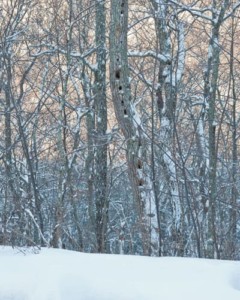
Pileated woodpecker holes become bird nesting and roosting habitat
We love our trees and mourn when our arboreal companions show signs of declining health. We pretend as long as we can that the shelf fungus growing larger each year is just a surface thing, not the fruiting body of mycelium inside the tree, inevitable agent of rot. The assertion in conservation circles, that “A dead tree supports more life than a living tree” is shocking but true. It’s clear to see – all around us – that dead and dying trees are part of a cycle.
A tree’s demise is the beginning of new life. So much so that experts recommend 3 dead or dying trees (“snags”) per acre to support wildlife – over 1000 species nationwide, according to the National Wildlife Federation. You can kill them yourselves by girdling the bark if need be.
ECOLOGICAL BENEFITS OF DEAD AND DYING TREES
- Shelf fungus such as Turkey Tails and yummy Chicken of the Woods form micro-habitats with their own food webs.
- Gigantic prehistoric-looking pileated woodpeckers jackhammer out chunks of wood, seeking a meal of the carpenter ants and termites already dining on the core of a dying tree.
- These excavations provide winter shelter and become food storage and nesting sites for bluebirds, woodpeckers, other cavity-nesting birds and small animals.
- The drumming you hear thrumming through the woods in spring, made by woodpeckers pecking on hollow trees or logs, is a sonic claim to territory. You can identify each woodpecker species by its distinctive sound pattern, which is sometimes amplified by the aluminum gutters on your house.
- Hawks and other birds of prey frequent snags, good places to survey surroundings, and smaller birds use them to perch and roost.
- Inner bark is colonized by insect larvae, pupae and eggs, food for flickers, sapsuckers.
- Outer bark shelters beetles, spiders, ants, butterfly eggs and larvae, even overwintering adults – more bird food.
And that’s only what we can easily see. Much of the soil food web that ties together all life forms remains unseen. Another shocking assertion I heard at a regenerative agriculture presentation – more than 95% of terrestrial life is underground.
Dying trees and branches don’t necessarily fall in convenient places. Some are clearly hazards that need to be removed. But if we treat woody debris as a resource rather than a disposal problem requiring the use of fossil fuels to carve up and cart off to a landfill, then even small actions foster life-giving solutions.
- Pick up sticks on the lawn, break them up and toss them into wooded areas where they won’t be underfoot – a great way to fool around outside and get some exercise without driving anywhere. Or challenge the kids to see how far they can throw – with or without the assistance of lurking Labrador retrievers, who are likely to return a few.
- Make an uncomfortable “nest,” of sticking-out sticks around trees to discourage deer foraging, rubbing and bedding down
- Start a brush pile, which will shelter all sorts of wildlife. Mine is full of roosting birds at night, a huddle of hibernating garter snakes throughout the winter and underneath, a cleverly concealed fox den. Take the time to artfully stack branches in mounds, tipis or windrows rather than tossing willy nilly.
- Edge woodland paths with gnarly limbs full of character and curves that gracefully follow twists and turns.
- Use nicely cut tree sections to create staging for planted containers, or plant right into hollows
- Stabilize steep banks with branches laid across the slope or make rustic log steps fastened in with short lengths of rebar or propped up by stones.
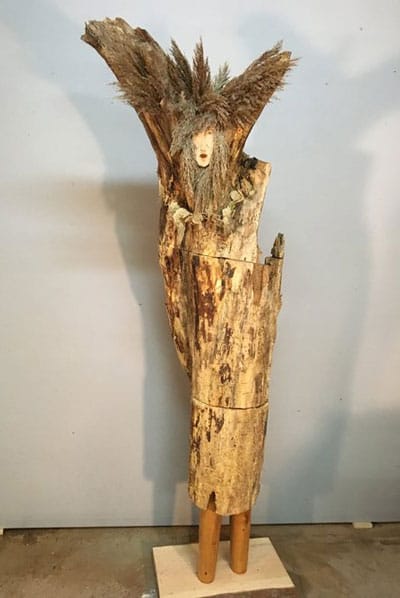
Brian Johnston sculpture, from “The Hidden Life of Trees” collection
Get creative, have fun, celebrate rot and renewal
TREE ART
Reading The Hidden Life of Trees inspired fine woodworker Brian Johnston to turn his talents to sculpting with twigs and downed patriarchs of the forest. “Anyone who has stood in the deep woods and listened, understands that more is going on than mere growth,” he says.
Brian’s The Hidden Life of Trees collection explores the kinship of forests and humans. His lyrical twig sculptures, “The Dancers,” playfully express “nature’s ballet.” CLICK HERE to meet his family of magical dendrological beings.
Artist W. Gary Smith created Art Goes Wild a delightful exhibition of artworks made from native plants and materials, at The Garden in the Woods in 2007.
These ephemeral works live on in photographs and in Smith’s award-winning book, From Art to Landscape: Unleashing Creativity in Garden Design. “Hidden Valley,” built of branches, remains in place. It zig-zags through the forest, dramatizing terrain hidden in plain sight amongst the trees.
Plan to visit Garden in the Woods, The New England Wildflower Society’s extraordinary native plant garden and headquarters, in Framingham, MA when they re-open on April 1. Or better yet, join NEWFS at the Garden Access level and enjoy Winter Walks on the grounds Monday-Friday for the rest of the winter.
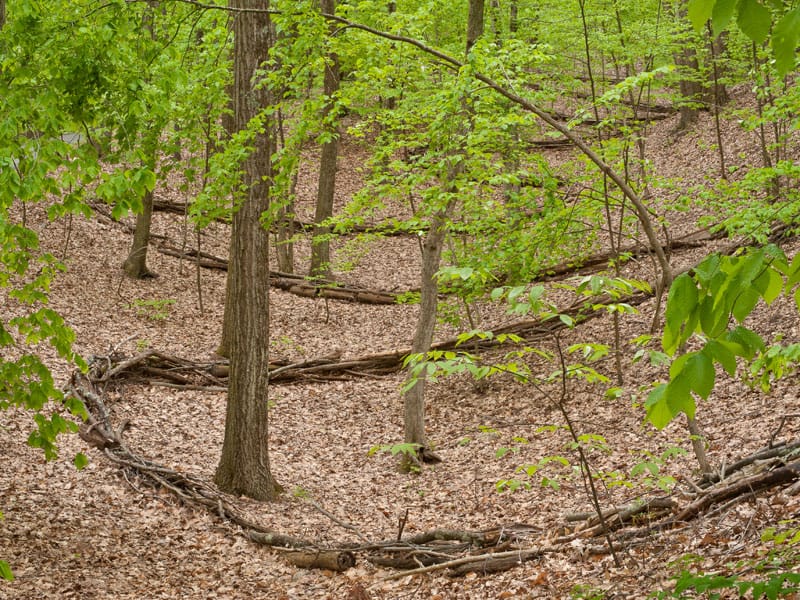
W. Gary Smith’s land art, “Hidden Valley” at Garden in the Woods

